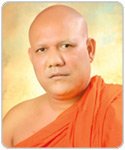|
The Three
Characteristics of
Existence
 Viharadhikari Viharadhikari
Bellanwila Raja Maha Viharaya.
Ven Dr. Boralesgamuwe Pemaratana
Buddhism stands unique in the history of religions as it explains that
understanding the ultimate nature of things as they are, is that there is no
permanent satisfaction of absolute entity. In this manner we understand the way
things really are, namely, impermanence (anica), dissatisfaction (dukkha) and
non-self (anatta) of all imaginable phenomena of the world.
During the Buddha’s Prince-hood, he, on encountering a sick person, an old
person and a corpse, realized the futility of life. It was these three stages of
life, namely sickness, ageing and death, that led him to seek the causes of
these facts of life. It was this yearning that led him to find the way towards
happiness and inner peace.
Anicca
 Realizing impermanence is the key to understanding the ultimate nature of
things. All objects, animate and inanimate, are characterized by impermanence
(Sabbe Samkhara anicca). They have no lasting or absolute entity and are subject
to decay. The understanding of impermanence gives us insight which is beneficial
to our practice of the Dhamma. This knowledge helps to lessen our attachment to
existence. This insight is an antidote to desire and ill-will, bringing a sense
of freedom and optimism. Realizing impermanence is the key to understanding the ultimate nature of
things. All objects, animate and inanimate, are characterized by impermanence
(Sabbe Samkhara anicca). They have no lasting or absolute entity and are subject
to decay. The understanding of impermanence gives us insight which is beneficial
to our practice of the Dhamma. This knowledge helps to lessen our attachment to
existence. This insight is an antidote to desire and ill-will, bringing a sense
of freedom and optimism.
Dukkha
Whatever is impermanent is unsatisfactory (Sabbe Samkhara dukkha). In our
ignorance of the real nature of things, we crave and cling to objects in the
unrealistic hope that they may be permanent and that they may yield permanent
happiness. We find that our bodies are impermanent, they too are subject to
constant change. We grow old and grey, our teeth fall out, our hair falls out,
still we long to hold on to our youth, try to remain healthy and to prolong our
lives. Also, we fail to recognize the impermanent nature of possessions. Their
impermanence is a cause of our suffering. This being part of our immediate
experience, we come to understand the emptiness of worldly things.
The Buddha said “All conditioned and compound things are indeed impermanent”
(Sabbe Dhamma anatta). Arising and cessation are inherent in them. Having come
into existence, they eventually cease. This clearly explains that whatever has
been born will surely die sooner or later. This is inherent in all of us. Not
only animate but inanimate objects are characterized by impermanence. Flowers
bloom, we enjoy their beauty but they soon fade away.
Anatta
Let us review the concept of “non-self” or Annata. In Buddhism, what we call
self or an individual, is composed of five aggregates. These are form (rupa
–kkhandha), feeling (vedana- kkhandha), perception (sanna-kkhandha), mental
formations (sankhara-kkhandha) and consciousness (vinnana-kkhandha). Objectively
seen, what we call “I” or “being” is only a combination of physical and mental
aggregates which are working together interdependently, changing from moment to
moment, within the law of cause and effect. There is nothing to take or consider
as “me” or “mine”. There is nothing permanent, everlasting, or unchanging in the
whole of existence.
The ideas of “me” and “mine” are the main factors for one to have selfish
desires,craving, attachment, hatred, ill will, conceit, pride, egoism and other
defilements, impurities and problems. This is the source of all the troubles in
the world from personal conflicts to wars between nations. In short, all the
evil in the world can be traced to this false view of “I” and “self.” Human life
does not exist as something unchanging. It changes due to various related
factors. Everything is interconnected. Everything, according to Buddhism, is
conditioned, relative and interdependent. The Buddha very clearly enunciated
this interdependence: “When there is this, that comes to be (Imasmin asati idam
hoti). With the arising of this, that comes to arise (Imassuppadam uppajjati).
When there is not this, that does not come to be (Imasmin asati idam na hoti).
With the cessation of this, that comes to cease (Imassa nirodha idam
nirujjhati).”
Simply: all conditioned things help each other to happen; and in turn, each
happening affects the other. Thus, every act is a reciprocal dynamic.
Understanding the impermanence (Anicca), suffering (Dukkha) and non-self
(Anatta) of all conditioned things is to truly comprehend the futility of
grasping things as our own. Let us strive to have greater understanding of the
Dhamma in daily life by dwelling on these irrefutable characteristics of worldly
existences.
May all beings be well, happy and peaceful...
 |
